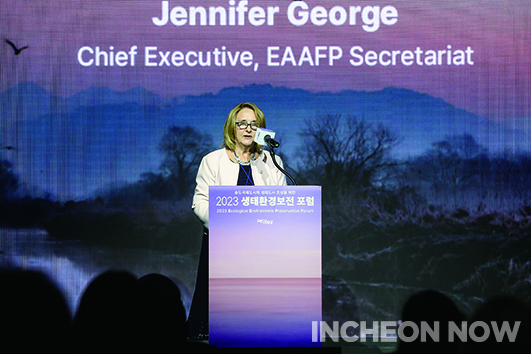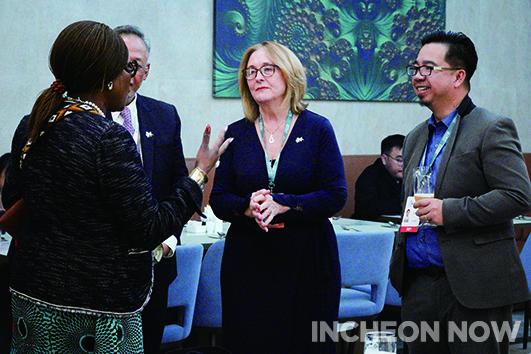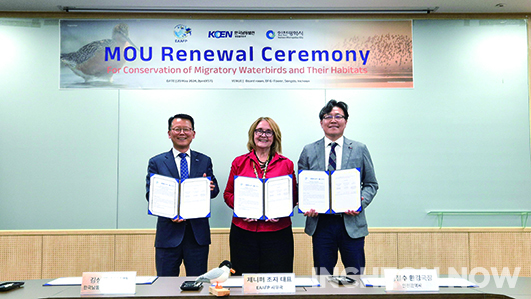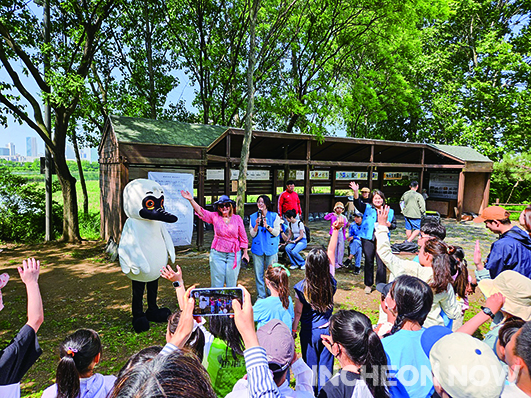[Beyound Borders]
THE FLIGHT OF MIGRATORY BIRDS, PROTECTING THEIR POWERFUL WINGBEATS
Migratory birds periodically move by season. The East Asian-Australasian Flyway of migratory birds is the largest on Earth. We interviewed Jennifer George, the Chief Executive of the East Asian-Australasian Flyway Partnership (EAAFP), who combined efforts to protect migratory birds and their habitats threatened by development and reclamation projects and pollution.

+ Interviewee : Jennifer George Chief Executive of the East Asian-Australasian Flyway Partnership(EAAFP)
Q. Thank you for taking the time to give an interview with Incheon Now, the English newsletter of Incheon. First, we are curious about EAAFP and its role, as well as the East Asian-Australasian Flyway(EAFF) mentioned in the title.
A. The East Asian-Australasian Flyway Partnership (EAAFP) is a collaborative network working to conserve migratory waterbirds, their habitats, and the communities that depend on these ecosystems. EAAFP brings together 18 governments, 22 organizations, and 156 important sites across 22 countries to collaborate on conservation. A key element of our work is building ecological connectivity for migratory waterbirds; a chain of internationally important sites for the migratory birds like the Black Faced Spoonbill who migrate twice a year between their breeding grounds here in Incheon to Hong Kong, China and other warmer countries when it gets cold here. The East Asian-Australasian Flyway (EAAF) is one of the world’s nine major migratory bird routes, stretching across 22 countries from the Russian Far East and Alaska to Australia and New Zealand. It supports over 50 million migratory waterbirds, including globally threatened species. These birds rely on wetlands during migration, but their habitats are under threat from climate change and development. Conservation efforts focus on preserving wetlands and fostering international cooperation to ensure their survival. The EAAFP coordinates international efforts in policy advocacy, scientific research, addressing climate change and biodiversity loss, and promoting sustainable development and public awareness to conserve migratory waterbirds. Specifically, we organize workshops and training to enhance conservation skills, protect critical habitats for migratory birds, and support research on their populations, habitats, and threats. These efforts are shared through events like World Migratory Bird Day and educational materials, such as the Flyway handbook. EAAFP also supports young leaders through the Flyway University Alliance, helping to build future conservation experts. In addition, we work with governments to integrate bird conservation into national policies, encourage Ramsar Site designations, and expand protected area networks.
Q. You have been working as EAAFP's representative for over a year. What has been your focus in leading EAAFP?
- A. As EAAFP's Chief Executive, I have focused on strengthening relationships to handle the vital task of conserving migratory waterbirds and their habitats. Our goal is to create a chain of internationally important breeding and wintering sites for these birds, fostering meaningful connections between the communities that depend on and care for them. Korea's tidal flats, for instance, are critical stopovers and vibrant ecosystems uniting people across the Flyway.
- With 40 partners and 156 Flyway Network Sites, building strong relationships across this vast network is challenging but essential. It requires dedication to fostering collaboration, mutual understanding, and a shared vision for conservation. Our host city, Incheon, has provided a stable foundation for 15 years, and our Secretariat in Songdo and Science Unit in Beijing tirelessly worked to empower communities, ensuring that the Flyway network thrives.

CMS COP 14(2024. 2. 13.)
The 14th Meeting of the Conference of the Parties to the Convention on the Conservation of Migratory Species of Wild Animals
Q. Among the many activities you led so far, which one do you remember the most?
A. There have been many memorable moments. Recently, we celebrated the addition of Yeoncheon as the 156th Flyway Network Site (FNS), marking the Republic of Korea’s 19th FNS and showcasing its conservation commitments. In Korea, I enjoyed the Big Bird Race in Gochang and the international symposia in Songdo and other cities. Another standout experience was the Sister Site exchange between Mai Po FNS [EAAF003] and Incheon FNS [EAAF145], where schools in Incheon and Hong Kong were connected. The Incheon students’ innovative and practical presentations to the Education Office after their visit to Hong Kong were impressive as it showed deep understanding of bird migration and conservation needs.
Another highlight was co-organizing a Science Symposium with Beijing Forestry University and launching the Flyway University Alliance in October 2024. This initiative brought together scientists to create the first EAAFP Science Strategy, incorporating indigenous perspectives. The University Alliance included 18 universities from EAAF Partner countries, to nurture the next generation of experts. These milestones have been deeply rewarding and energizing for our mission.

Incheon and EAAFP participated in the Wetland Management Training and Exchange Program held in Hong Kong from January 8 to 12, 2024,
and discussed ways to preserve migratory water to preserve migratory water birds and wetlands in Incheon with the World Wide Fund for Nature(WWF) Hong Kong Office and the Agriculture, Fisheries and Conservation Department(AFCD) of Hong Kong.
Q. Many migratory birds are found in Incheon because it has tidal flats. Could you explain what types of migratory birds mainly stop by in Incheon and their migration routes?
A. Incheon’s tidal flats are an essential stop for many migratory birds traveling along the East Asian-Australasian Flyway. Especially, some endangered species stop here include the Blackfaced Spoonbill, which nests and feeds in the area, and the Spoon-billed Sandpiper, a rare and critically endangered bird. Many shorebirds such as the Great Knot, Bar-tailed Godwit, Dunlin, Far Eastern Curlew, Saunders’s Gull, Grey Plover, and Red-necked Stint, etc rely on Incheon’s tidal flats to rest and refuel during their long migrations.

Jennifer George, Chief Executive of EAAFP, attended the "2024 Black-faced Spoonbill Birthday Party "hosted by EAAFP at Namdong Reservoir in Incheon on May 18, 2024,
and spent time with elementary school students.
Q. In 2021, Incheon selected five species (the blackfaced spoonbill (Platalea minor, migratory bird), spotted seal (Phoca largha, mammal), white-claw fiddler crab (Uca lactea, invertebrate), Vesper iris (Iris dichotoma Pall, plant), and Korean golden frog (Pelophylax chosenicus, amphibian)) as its representative ‘Incheon Flagship Birds’ in promoting environmental protection policies. If there are Incheon’s environmental protection activities that impressed you, please tell us.
A. The Namdong Reservoir exemplifies Incheon’s commitment to saving the black-faced spoonbill. Thanks to these efforts, its population has increased from around 2,500 to 6,000. This success is due to the two protected breeding sites supported by citizens, researchers, an NGO, and Incheon City. Another impressive initiative is Incheon City’s support in exchange programs with Mai Po, Hong Kong[EAAF003], a leading Flyway site. These exchanges allow local government officers to share knowledge about habitat conservation and restoration, fostering collaboration to protect migratory birds connecting these regions. Such proactive and cooperative efforts are impressive as it shows Incheon’s dedication to environmental protection.
Q. We would also like to know the image of Incheon that you have in mind.
A. I live in Songdo and to me, it is clean, safe, and attractive. Incheon is remarkable for its efforts to foster a global mindset among its citizens, embracing international ideas and connections to create a vibrant and forward-thinking community.
Q. Do you have any words for Incheon citizens, 10 million overseas Koreans, and foreigners visiting Incheon?
A. To all the citizens, the overseas Koreans, and visitors: There is something truly incredible here. The tidal flats of the Yellow Sea, with Incheon at its heart, are bursting with life—birds, insects, crabs, worms, and countless creatures, hidden beneath the surface. These flats are the planet’s best carbon sinks and home to underwater plants that produce oxygen, food, and protection for sea life. You might not notice it, but they are hidden treasures essential for the planet’s health and the shared web of life. So, take pride, celebrate their wonders, and do your part to protect these vital ecosystems!